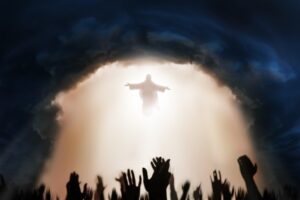By David Parsons, ICEJ Senior Spokesman.

This Passover, with Israel at war, it is enlightening and comforting to reflect not only on God’s mighty deliverance of the Israelites from Egypt some 3,500 years ago, but also on the great prophetic significance of this historic event. Most Christians are familiar with how that first Passover cast a long shadow forward to the first coming of Jesus and his redemptive work on the Cross. But according to the Hebrew prophets and the New Testament as well, the Exodus story also serves as a prophetic guide for the end of the age and his Second Coming.

Jesus, our Passover lamb
The physical deliverance of Israel from the bondage of slavery in Egypt was a foreshadowing of the spiritual deliverance we have in Messiah, whose atoning death has set us free from the bondage of sin (Romans 6:17-18; Galatians 5:1; Colossians 1:13-14). Just as God spared the Israelites from the “destroyer” when He saw the blood of a lamb sprinkled on their doorposts, the shed blood of Jesus the Messiah allows God to “pass over” our sins completely (Romans 3:25; 1 Corinthians 5:7).
In the Passover story it is Moses who is the central figure. He was the Deliverer promised beforehand by God to free the Hebrew children from bondage in Egypt (Genesis 15:13-14). Likewise, Yeshua (Jesus) was a promised Deliverer anticipated by his people (Daniel 9:24-26; Micah 5:2; Matthew 1:21, 2:4-6; Galatians 4:4).
Indeed, the many parallels between Moses and Jesus are quite remarkable, including that both would suffer rejection by their own people (Numbers 14:22; Deuteronomy 18:15; Acts 3:14-18, 7:38-39).
The Last Supper which Jesus held with his disciples was undoubtedly modelled on a Passover seder meal. When Jesus came to the traditional third cup of wine at Pessach – the cup of redemption – he stated: “This cup is the new covenant in My blood, which is shed for you.” (Exodus 6:6; Luke 22:20)
Just as the matza (unleavened bread) of Passover has small holes and stripes (to allow the air to escape while baking to prevent rising), the body of Jesus was pierced for our transgressions and his back bore stripes for our healing (Psalm 22:16; Isaiah 53:5; Matthew 27:26; John 19:31-37).
And just as Israel was commanded to observe the Passover meal every year in remembrance of their Exodus from Egypt, Jesus told his disciples to continually partake of the bread and wine of the Last Supper in remembrance of what he was about to suffer for their sake (1 Corinthians 11:25).
Other details in the Gospels clearly demonstrate how closely Jesus resembled the sacrificial lamb of Passover tradition. He was thoroughly examined for flaws by the Jewish priests and even the Roman authorities. He died on a cross right as the last Passover lambs were being slaughtered in the Temple courts and none of his bones were broken (Exodus 12:9; Psalm 34:20; John 19:33-36).

Hidden and Revealed
So, we find that great prophetic and redemptive purposes which lay hidden in the original Passover experience were openly fulfilled during that fateful Passover at the first coming of Jesus some 2,000 years ago. But how does the Exodus story relate to his Second Coming?
End-Time and the Exodus
Interestingly, the Bible also draws a clear analogy between the Israelite departure from Egypt and God’s dealings with Israel and the Gentile nations at the end of the age. For instance, Jeremiah said the last-days return of Israel will mirror the Exodus and even exceed it in magnitude.
“Therefore behold, the days are coming,” says the Lord, “that it shall no more be said, ‘The Lord lives who brought up the children of Israel from the land of Egypt,’ but, ‘The Lord lives who brought up the children of Israel from the land of the north and from all the lands where He had driven them.’ For I will bring them back into their land which I gave to their fathers.” (Jeremiah 16:14-15)
This same parallel is found again in Jeremiah 23:7-8, where the context once more is the final Ingathering of the Jewish people to their ancient homeland. Here, it has the added element that the promised “Branch,” or Messiah, will come on the scene at this time to gloriously reign, such that “Judah will be saved, and Israel will dwell safely…” (Jeremiah 23:5-6).
Zechariah chapter ten carries a similar message, even adopting clear imagery from the parting of the Red Sea to describe this future time when Jews would depart from the Gentile nations and journey home to the Land of Israel: “He shall pass through the sea with affliction, and strike the waves of the sea: All the depths of the River shall dry up.” (Zechariah 10:11)
Elsewhere, the prophet Micah foresees a time when Israel is finally restored to her land and to her God, even while He is dealing with the nations in an Exodus-like scenario, saying: “As in the days when you came out of the land of Egypt, I will show them wonders.” (Micah 7:15) The prophet also sees the Lord “passing over” the transgressions of the remnant of His people – employing the same Hebrew word abar used in Exodus 12:23 to describe how the Lord would “pass through” the land to strike the Egyptians on the night of the Passover.
Now over the past century or so, we have witnessed the incredible return of the Jewish people from the many lands of their dispersion and captivity, just as the Hebrew children were freed to leave Egypt and start out for the Promised Land. But we have yet to see the mighty hand of God truly humbling the nations for harshly mistreating the people of Israel, like He did with Pharaoh and his army at the crossing of the Red Sea. Yet that day is surely coming.
The Judgement of the Nations
Consider that many of the judgments foretold in Revelation closely parallel the plagues which struck Egypt. Of the ten plagues described in the book of Exodus, five are also found in Revelation. This includes hail mingled with fire (Revelation 8:7); the seas and rivers turned to blood (8:8, 16:3-4); locust (9:1-11); loathsome sores like boils (16:2); and darkness (16:10-11).
In addition, the Two Witnesses who show up in Revelation 11 have powers much like Moses (and Elijah) to call down fire from heaven, to stop the rains, to turn water to blood, and “to strike the earth with all plagues, as often as they desire.” (Revelation 11:5-6) One school of thought maintains that – just as Moses called forth every plague on Egypt in the midst of Pharaoh’s court – these two anointed figures will be in Jerusalem calling down all the judgments occurring over the three-and-a-half year period described in Revelation chapters six through nine. This view is supported by verse 10, which states that the whole world will rejoice over their death, because “these two prophets tormented those who dwell on the earth.”
God’s judgment of the nations in the last days is often described by the Hebrew prophets as culminating in Jerusalem, such as in Joel 3:1-3. It is as if the nations have released the Jewish people to go back home, but then have second thoughts and pursue them there, like Pharaoh did of old. The prophet Zechariah, in chapter 14, also speaks of that day when God will gather all nations to Jerusalem for judgment.
Although the city sees great destruction, the Lord Himself will appear on the scene and “fight against those nations, as He fights in the day of battle.” (Zechariah 14:3)

The prophet then describes the Lord standing with his feet on the Mount of Olives, which miraculously splits in half to open a pathway of escape for the people of Israel (Zechariah 14:4-5). This prophesied event bears such an uncanny resemblance to the parting of the Red Sea that we must conclude it is yet one more example in the Bible of Exodus analogy connected to the End-of-Days.
It is one thing for waters to part to allow a people to flee and then come back together to drown the pursuing enemy. How much greater a wonder to behold will be the parting of a mountain to deliver His people just when the nations are closing in on Jerusalem! Indeed, the modern-day Exodus is far from over and its end will be more awesome than that first Exodus long ago; yea, more awesome than we can even imagine.
Truly, “the Lord lives!” The very Lord who died on a cross at Passover that we might live with Him forever.




